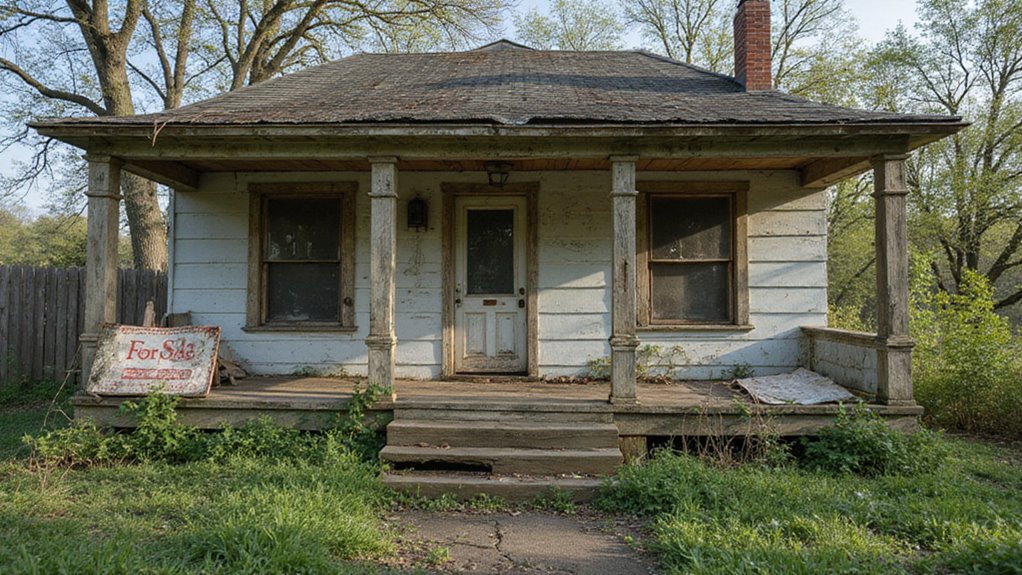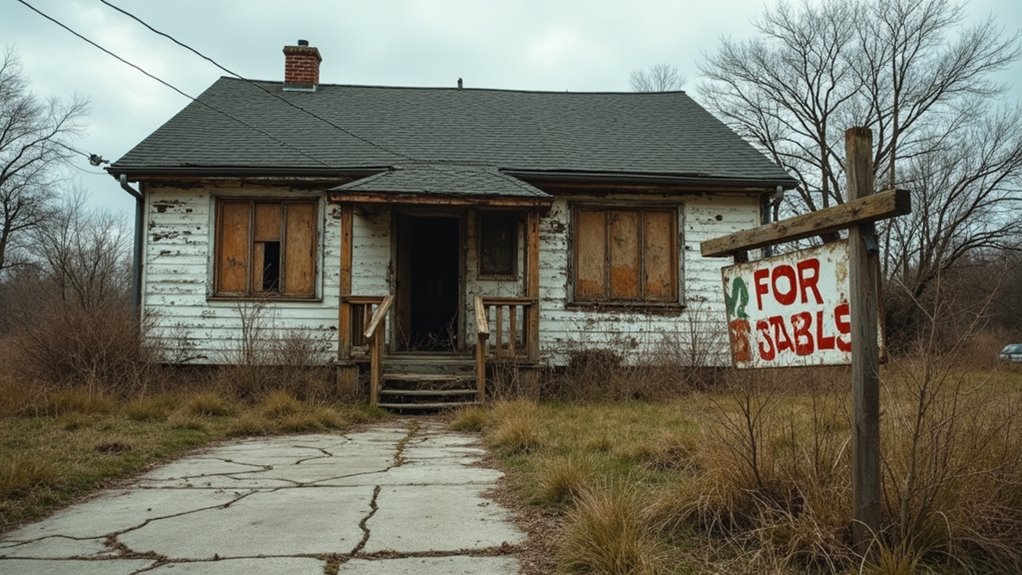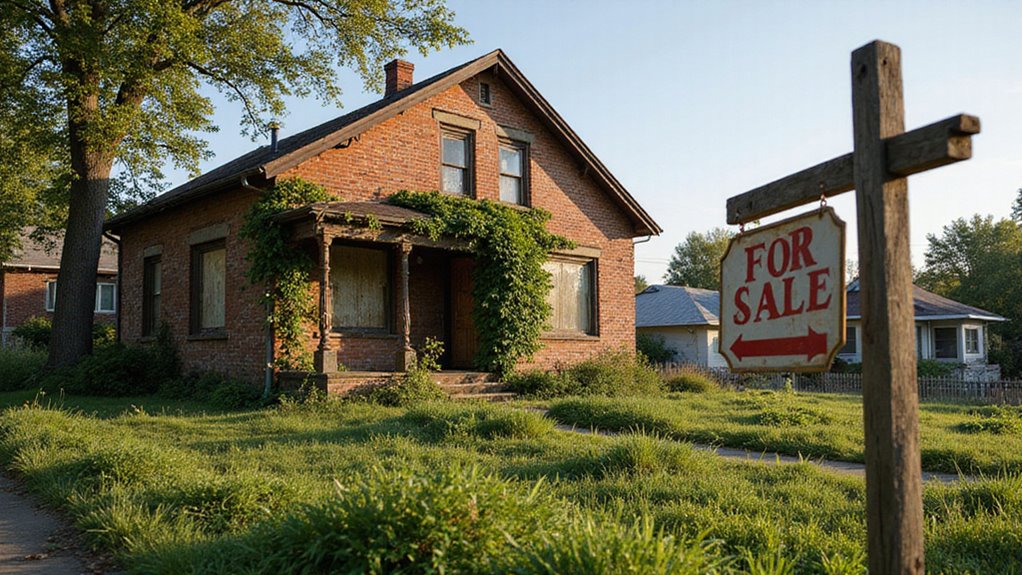How to Sell a Fixer Upper House Fast?
Stuck with a crumbling house that won’t sell? Outdated kitchens, worn flooring, and peeling paint drive away potential buyers faster than you can say “fixer-upper.” These repair-heavy properties often languish on the market while eating away at your finances through taxes and maintenance. Thankfully, proven strategies exist to help you unload that fixer-upper quickly, regardless of market conditions.
To sell a fixer-upper fast, price it competitively by deducting repair costs from the after-repair value and target renovation-ready investors or cash buyers. Make simple, low-cost improvements like decluttering and deep cleaning to enhance appeal without major investment. Consider as-is listings, auctions, or direct buyer companies for expedited closings with fewer complications.
In this blog I will explore seven proven strategies to sell your fixer-upper house quickly in any market.
Key Takeaways
- Price the property competitively by assessing repair costs and market value to attract quick offers.
- Enhance curb appeal with simple landscaping and fresh paint to create a strong first impression.
- Disclose all issues and provide documentation to build trust and streamline the sale process.
- Target cash buyers and investors looking for renovation opportunities for faster transactions.
- Consider selling as-is through auction or direct sale to reduce time on market.
What is a Fixer-Upper House?

A fixer-upper house needs repairs, updates, or remodeling to boost its value and appeal to buyers. These homes often have structural, electrical, or plumbing issues, along with cosmetic flaws like outdated finishes.
Unlike condemned properties, fixer-uppers are livable and can be sold as-is, making them prime targets for quick, profitable sales.
Definition and Characteristics
Fixer-upper houses need major repairs or renovations before becoming livable. These properties show obvious defects such as old kitchens, damaged roofs, or foundation problems. Investors often seek these homes for their profit potential. As a result, these properties typically sell below market value.
Cosmetic issues lower prices while attracting renovation-minded buyers. Structural problems require professional contractors with proper licensing.
Safety concerns arise from outdated electrical or plumbing systems. Furthermore, the neighborhood quality affects the final property value regardless of condition.
Repair costs directly determine appropriate pricing and marketing strategies. Most buyers calculate potential profit by subtracting renovation expenses from the estimated after-repair value.
Common Issues Found in Fixer-Upper Homes
Fixer-upper homes typically suffer from structural, cosmetic, and system-related problems. Foundation cracks, roof damage, outdated electrical systems, plumbing issues, and pest infestations top the list of common concerns.
These problems often hide behind walls or beneath floors, surprising new owners. Mold and water damage frequently appear in older properties, particularly in basements and bathrooms.
Additionally, many fixer-uppers need window replacements, HVAC system upgrades, or complete kitchen renovations.
In most cases, these issues require professional assessment before purchase. For instance, foundation repairs can cost $15,000-$25,000 depending on severity.
Difference Between Fixer-Upper and Condemned Property
A fixer-upper needs cosmetic updates while a condemned property is officially declared unsafe for habitation.
Fixer-uppers remain structurally sound and livable during renovations. Their issues are typically superficial and can be addressed while you live there. Most repairs add immediate value to the property.
In contrast, condemned properties have serious safety violations that make them illegal to occupy.
These properties require major structural repairs or complete demolition before anyone can live there. Local authorities must inspect and approve all remediation work. Furthermore, financing options are extremely limited for condemned homes.
Why Selling a Fixer-Upper Can Be Challenging?

Fixer-uppers attract lower offers because buyers see repair costs as financial risks. Most people want move-in ready homes without unexpected expenses.
Repair costs often exceed buyer estimates, causing hesitation during negotiations. Many buyers lack vision to see potential in outdated or damaged properties.
However, certain buyers specifically seek unrenovated homes at reduced prices. Cash buyers typically show more interest in fixer-uppers because they can close quickly without financing complications.
These investors calculate renovation costs against potential profits. Transparency about known issues builds trust and prevents legal problems later.
To succeed with a fixer-upper sale, focus on highlighting possibilities rather than problems. Price the property realistically to reflect its condition. Consider obtaining pre-inspection reports to ease buyer concerns.
What Determines the Value of a Fixer-Upper Home?

Your property’s value hinges on its location and neighborhood appeal, which influence buyer interest regardless of condition.
Structural issues drastically reduce worth, while cosmetic repairs can boost perceived value with minimal investment.
Keep market conditions in mind, as distressed homes sell faster when demand is high, especially in sought-after areas.
Location and Neighborhood Factors
Location affects property value most when renovating a fixer-upper. Properties near desirable amenities sell for higher prices.
Smart investors focus on three key factors. Proximity to schools, parks, and shopping centers increases appeal to potential buyers.
Watch for neighborhood improvement trends that signal future value growth. Good access to transportation and major roads also boosts property desirability.
These location priorities help investors sell faster and earn more profit. Before purchasing any fixer-upper, carefully evaluate the surrounding area. Even beautiful renovations can’t overcome a poor location.
Structural vs. Cosmetic Issues
Structural issues impact home value much more than cosmetic problems. Foundation damage can decrease a home’s value by 20-50% because it threatens safety and requires expensive repairs. These problems often scare away potential buyers and mortgage lenders.
Cosmetic flaws like outdated fixtures or worn carpet have a smaller impact. These issues typically reduce value by only 5-15%. Most buyers can easily fix these problems after purchase. As a result, homes with only cosmetic issues sell faster than those with structural damage.
In other words, buyers worry about the bones of the house, not its appearance.
Market Conditions for Distressed Properties
Distressed properties sell best in seller’s markets with limited inventory. Price discounts typically range from 15-30% below market value depending on repair needs.
Investors actively seek these opportunities when housing demand exceeds supply. The condition, location, and neighborhood stability greatly affect buyer interest.
Additionally, economic factors influence distressed property sales. Low interest rates encourage more investor activity. Local employment rates impact neighborhood stability and future appreciation potential.
Properties requiring cosmetic updates rather than structural repairs typically sell faster and at better prices.
How to Prepare Your Fixer-Upper for a Quick Sale?
Get your fixer-upper market-ready by tackling essential repairs that boost safety and appeal, like fixing leaks or updating the roof.
Spruce up the space with cost-effective cosmetic upgrades such as fresh paint and neat landscaping to attract buyers quickly.
Finally, clean thoroughly, declutter, and organize all documentation of past repairs to demonstrate transparency and build buyer confidence.
Essential Repairs Worth Making
Fix major systems first. Plumbing, electrical, and insulation repairs build buyer confidence and prevent inspection issues. Buyers typically pay 3-5% more for homes with updated systems. Safety concerns must be addressed immediately.
Foundation cracks, roof damage, and structural problems can derail sales completely. Consequently, investing in these repairs protects your investment. Most buyers want move-in ready homes.
Document all completed repairs with receipts and warranties. This documentation provides proof of quality work. Home inspectors will check these key areas first during the buying process.
In most markets, these essential repairs deliver the highest return on investment.
Cost-Effective Cosmetic Improvements
Small, affordable changes can dramatically boost your home’s appeal and selling speed. Fresh neutral paint, deep cleaning, and decluttering create an inviting atmosphere buyers can envision living in. These simple fixes often cost under $500 but can yield thousands in return.
For the exterior, focus on basic landscaping improvements. Trim overgrown bushes, plant colorful flowers, and ensure the lawn looks well-maintained.
First impressions matter – 94% of buyers form opinions within the first 10 seconds of seeing a property.
Additionally, replace worn doorknobs, outdated light fixtures, and clean or replace cabinet hardware for modern appeal.
Professional Cleaning and Decluttering
Professional cleaning and decluttering create buyer-ready homes that sell faster. Hire professional cleaners to tackle every surface and hidden area in your home. They reach spots homeowners often miss. A deep clean makes your property shine in photos and during showings.
Remove excess items to make rooms feel spacious and inviting. Experts recommend removing at least 30% of your belongings before listing. This helps buyers visualize themselves living in the space. Personal items like family photos should be packed away.
In fact, clean, decluttered homes often receive higher offers. The investment in cleaning services typically provides excellent return.
Documentation of Issues and Previous Repairs
Complete repair records build trust and simplify selling damaged properties. Document all issues, fixes, and persistent problems to show transparency. Buyers appreciate honesty about property conditions. This approach helps them make informed decisions.
A pre-listing inspection reveals unknown issues before buyers discover them. Records of repairs should include dates, costs, contractor information, and warranties. These details justify your asking price and prevent negotiations based on surprises.
Cash buyers and investors value properties with clear histories. They can assess risks more accurately with proper documentation. Your thorough records demonstrate responsible ownership. This preparation often leads to faster sales and smoother transactions.
What Are Your Options for Selling a Fixer-Upper?
You have several options for selling your fixer-upper quickly and profitably. You can sell as-is to cash buyers or investors, list traditionally with full disclosure, or auction the property to attract motivated bidders.
Choose the approach that aligns with your timeline, financial goals, and the condition of your home.
Selling As-Is to Cash Buyers
Cash buyers purchase homes in their current condition without demanding repairs. This approach saves time and reduces hassle. You can attract these buyers by pricing your property based on after-repair value minus renovation costs.
Disclose all known defects honestly to avoid legal issues later. The right marketing targets investors looking for opportunities. Many cash buyers seek properties they can improve for profit. Your transparency builds trust with potential purchasers.
Furthermore, these transactions typically close faster than traditional sales. Without financing contingencies, the process moves quickly and smoothly.
Working with Real Estate Investors
Real estate investors purchase fixer-uppers quickly for cash with minimal hassle. They buy properties as-is, eliminating the need for repairs or staging. Your agent can connect you with reliable local investors from their professional network.
Most investor transactions close within two weeks compared to 30-45 days for traditional sales. This option works well when you prioritize speed over maximum profit.
Many investors handle all paperwork and closing costs to simplify the process further. Additionally, you avoid inspection contingencies that might complicate traditional sales.
Traditional Listing with Full Disclosure
A traditional listing with full disclosure is the safest way to sell a fixer-upper. You must share all known property defects through a Seller’s Disclosure Notice. This transparency protects you legally and builds buyer trust.
Proper valuation of fixer-upper properties helps establish a realistic price that attracts serious buyers. The right price point acknowledges existing problems while remaining competitive in your market.
As a result, you’ll find qualified buyers faster. Emphasize renovation potential in your listing. This approach appeals to DIY enthusiasts and investors looking for opportunities.
Furthermore, highlighting potential value after repairs often justifies your asking price.
Auction Sales for Distressed Properties
Auctions provide a quick solution for selling distressed properties when time matters. They attract cash buyers and investors looking for renovation projects. You might receive multiple bids, creating competition that can increase your final sale price.
The process follows a set timeline with a guaranteed end date. This certainty appeals to sellers who need to resolve property issues promptly. Most auction properties sell within 30-45 days of listing.
Furthermore, auctions draw serious buyers ready to purchase properties as-is. These motivated investors understand the renovation needs and come prepared with funds.
The straightforward nature of auctions eliminates lengthy negotiations and contingencies.
How to Price Your Fixer-Upper Correctly?
To price your fixer-upper effectively, start with a solid comparative market analysis to see what similar homes sell for in your area.
Next, subtract estimated repair costs and include a buyer risk margin to set a competitive, attractive price.
Price slightly below market value to generate quick offers and keep your sale moving fast.
Comparative Market Analysis for Distressed Homes
Accurate pricing requires a thorough comparative market analysis when selling distressed properties. First, examine recent sales of similar fixer-uppers in your area.
Adjust comparable sales based on condition differences and required repair costs. Then determine the property’s After Repair Value by calculating what it would sell for in excellent condition.
Subtract estimated repair costs from this figure. This calculation provides your baseline asking price.
Most successful distressed property sellers price slightly below this baseline. A competitive price attracts more potential buyers and generates faster offers.
This strategy particularly appeals to investors seeking good returns on their renovation dollars.
Factoring in Repair Costs
Subtract repair costs from your home’s After Repair Value to price fixer-uppers correctly. This prevents overpricing that can deter potential buyers.
A fair price calculation looks like this: ARV minus renovation costs equals asking price.
Realistic pricing attracts serious buyers looking for properties needing work. Your transparency builds trust with house hunters who appreciate honest assessments. Buyers often run their own calculations on repair costs before making offers.
Therefore, accurate repair estimates demonstrate integrity and market awareness. This approach speeds up your selling process while ensuring fair value for both parties.
Setting a Price That Attracts Quick Offers
Price your fixer-upper slightly below market value to generate immediate interest. Start by completing a Comparative Market Analysis (CMA) with similar properties in your area.
Calculate the After Repair Value (ARV) and subtract all repair costs plus a 10-15% margin for buyer risk. This formula reveals your ideal asking price.
A strategic price creates urgency and often leads to multiple offers. Many sellers find this approach results in faster sales and sometimes bidding wars.
Additionally, this pricing method appeals to investors and wholesalers seeking value opportunities. The right price ultimately saves you carrying costs and reduces time on market.
Ready to Sell Your Fixer-Upper Fast? Next Step House Buyers Can Help
Next Step House Buyers can help you sell your fixer-upper quickly. We purchase properties in any condition without requiring repairs or improvements. We provide cash offers within 24 hours and can close in as little as 7 days.
Our straightforward process eliminates the typical stress of home selling. No need for showings, inspections, or haggling with traditional buyers. Furthermore, we handle all paperwork and logistics.
The experience is tailored to your specific situation and timeline. As a result, you can move forward with your life faster. There are no hidden fees or commissions when selling directly to us.
Frequently Asked Questions
How to Sell a Fixer-Upper House Fast?
Coincidentally, you can sell your fixer-upper fast by pricing it competitively, highlighting its promise, and targeting cash buyers and investors. Clear disclosures, professional visuals, and emphasizing safety repairs attract motivated buyers seeking quick, profitable transactions.
What Not to Fix Before Selling?
You shouldn’t fix minor cosmetic issues like outdated fixtures or paint unless it boosts appeal. Focus on major repairs, like foundation or roof issues, that protect buyers’ safety and justify your asking price, serving their needs efficiently.
What Is the Hardest Month to Sell a House?
December hits like a snowstorm—slowing your sale. You face holiday distractions, lower buyer activity, and stiff competition. Act fast, price competitively, and highlight your home’s unique value to serve buyers even in tough months.
What Sells a House the Fastest?
You sell a house fastest by pricing it competitively, enhancing curb appeal, staging effectively, providing clear disclosures, and leveraging high-quality photos or virtual tours. Focus on quick, strategic updates that attract motivated buyers and investors swiftly.
